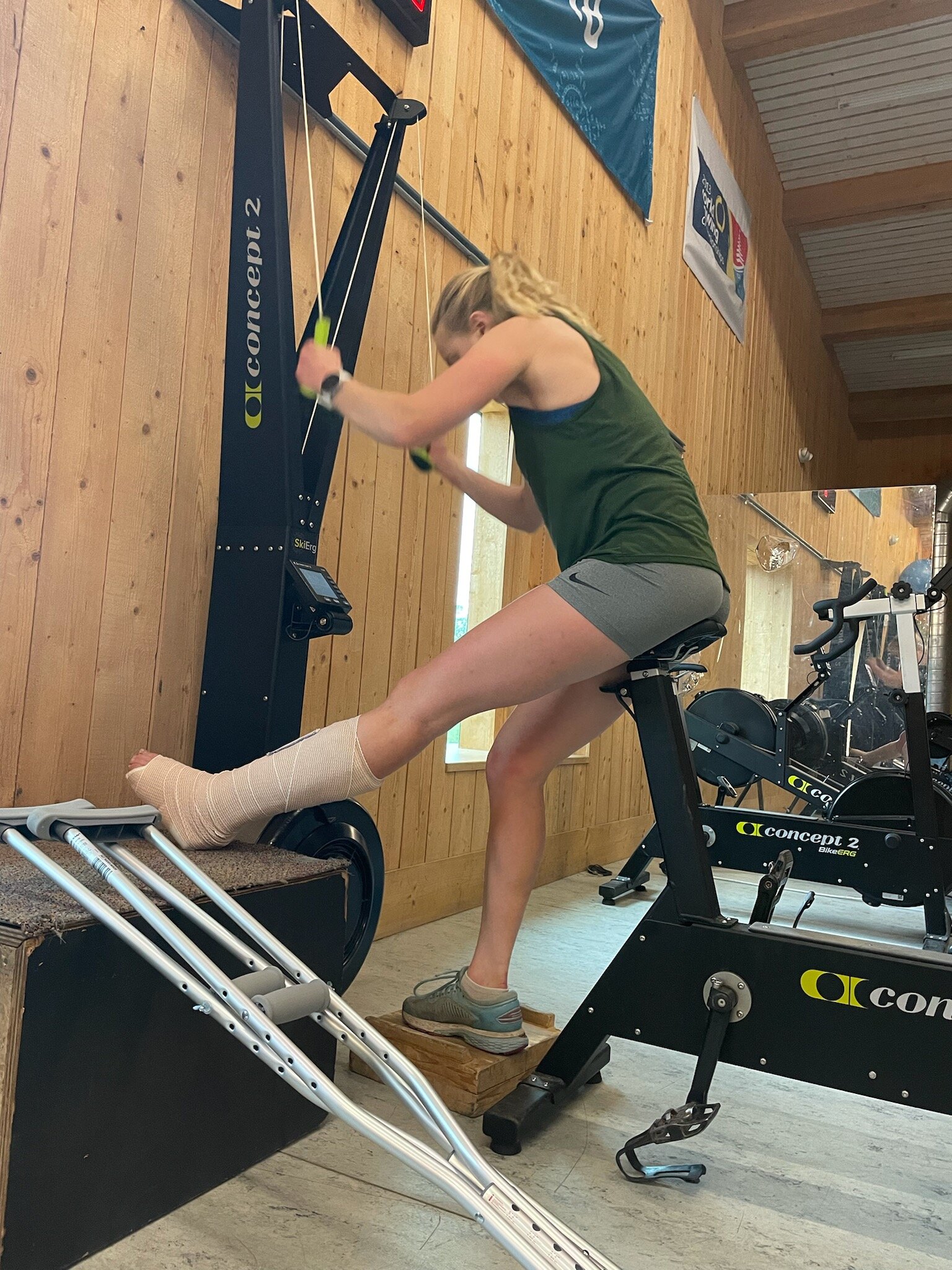The Injured Person’s Training Plan (Crutches Included)
Written by Michaela Keller-Miller
As the age-old adage goes, even the best-laid plans go awry. Endurance athletes are no stranger to setbacks and injuries, but the good news is that there is never just one way to reach a goal. The alternative route may be circuitous and full of unexpected barriers, but this will make reaching the destination even more gratifying. As someone who is more injury prone than I’d like to admit, I have a few tricks up my sleeve on successfully staying fit and mentally engaged throughout the healing process.
This past June I added a broken ankle, complete with torn ligaments, to my growing laundry list of injuries. Although I was disappointed to put “normal” training on hold, I shifted my energy toward finding ways to maintain fitness as best I could.
My view of the skierg setup.
Tailor your training plan to what you CAN do:
In my case, I was completely non-weight bearing on one leg following surgery. This didn’t leave many options; however, with a little creative problem solving, Coach Pepa crafted a one-legged sitting SkiErg setup. GRP biathlete Hallie pioneered the single leg sit Erg a few years back while recovering from knee surgery, and Pepa was quick to note that Hallie came back extra fit that Fall. It’s no surprise that the sit SkiErg would not be my training mode of choice, but as an injury training tool, it has proved invaluable to both my sanity and staying on track toward my skiing goals.
Alternate training options for lower body injuries could include kayaking, upper body strength, and core. I found that SkiErging for two or more hours every morning fried my arms, so I tended to stick to afternoon core sessions rather than arm exercises like bench press or pullups. If you have access to a kayak, it can be a fun way to get some fresh air.
As I started being able to expand activity options, I began spin biking and aqua jogging. The physical therapist I started seeing post-surgery even mentioned that one of his patients took off a pedal on a spin bike so that they could one-legged bike. Since exclusively training in the gym isn’t always the most exciting, it’s important to celebrate the little milestones. The addition of spin biking to my activity arsenal may not have been the same as rollerskiing, but it gave my arms a much-needed break. The switch to standing SkiErg was especially sweet, as I could finally start regaining leg strength.
Going for a bike with teammate Rena, who also was recovering from a foot injury!
Get creative with your activity! I’ve had friends who are unable to run, but can still hike, do tram laps at their local ski resort to accumulate a long, easy distance effort. Since trams are typically free to ride down, you can hike up the mountain on a cat track or toll road with a free lift back down. Depending on the size of the mountain, you can continue lapping back up and down. This can be a great way to raise your heart rate with limited breaks, relatively smooth footing, and low impact. There are many resourceful ways to stay in shape while injured if you seek them out. The type of activity matters less than consistently staying active, however you are able.
Keep training interesting:
In addition to switching up training modes (i.e. stationary bike, SkiErg, hiking, road bike, etc.) given your constraints, adding variety to the type of workout is crucial to staying engaged and motivated. This includes mixing it up with intervals, speed sessions, and over distance workouts.
Even if you normally struggle to fit in a higher-intensity session each week, cross training intervals are a great place to start. They help to break up the monotony of what is likely a lot of stationary activity. I strive to fit in two sessions a week; these include both a level 3 and a level 4 interval set.
Level 3, or L3 as skiers call it, is a threshold pace just under your 5- or 10-kilometer race pace. As it’s harder to clear lactate during stationary activity, it’s okay to accumulate less interval time than you would during a rollerski or running workout. One of my favorite SkiErg or stationary bike L3 workouts is 2-3x15 minutes at L3 with three minutes of rest in between each interval. Another great workout that allowed me to simulate the pace changes that come with outdoor terrain was 40 seconds at L3 pace, followed by 20 seconds at easy distance pace for 25 total minutes. After a five-minute break, you can choose to do a second set of 25 minutes.
Level 4, or L4, should feel like your race pace and is a good way to work toward race shape. A go-to for me this summer was 3-4x4 minutes on the SkiErg. I would oftentimes add several all-out 30 second sprints following the L4 intervals to work on turnover.
Other options to diversify your training plan can include adding a speed session. This can be as simple as tossing 10x15-20 second all-outs into your easy distance session. I also enjoyed setting a goal of one over distance session each week. When I was exclusively sit SkiErging, this would be around two and a half hours. However, when I could spin bike and standing SkiErg, I set a goal to end a training block with a four-hour distance session. Although this was self-admittedly a little crazy and by no means critical to my training plan, finishing that workout gave me a sense of accomplishment and was proof to myself that fitness can be maintained while cross training.
Airpods are your friend:
Training through injury can be lonely, especially if you are used to working out with friends or outdoors. Wireless headphones have been lifesavers in keeping me entertained throughout long, solo gym sessions. Find a new TV show, podcast, or audiobook to keep you company during your next workout. If you need a bit more focus or motivation for an interval set, create a new workout playlist ahead of time. It’s easy to let stationary gym sessions get to your head, especially when the end is not necessarily in sight. I’ve found wireless earbuds to be a game changer in staying focused and keeping me from daydreaming about what I’d rather be doing, like running or skiing outside.
Filter your thoughts:
Even if you do everything in your power to keep training interesting and distract yourself with new music, injuries can be the ultimate test of mental toughness. It’s okay (and normal!) to not love cross training and to let negative thoughts slip into your head. However, instead of dwelling on these feelings, try your best to filter out these thoughts and focus on what you’re doing well. Be proud of yourself for what you can do and for being strong enough to creatively train through an injury. Plus, your newfound mental toughness will help you to dig deeper when you’re back to racing.
Cross training while injured is an unglamorous part of sport. Getting through these periods of training can be challenging, but it helps to be thankful for what you are still able to do. Always remember, every alternative workout brings you one step closer on the winding road toward reaching your goals.



